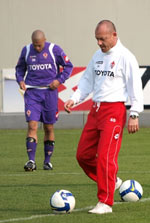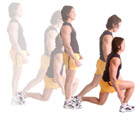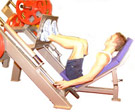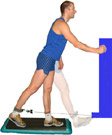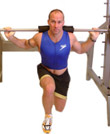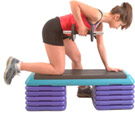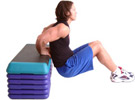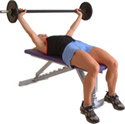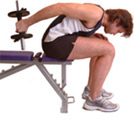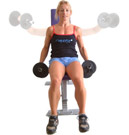It's always a good time for football training drills and exercises as unless you are in the Premiership - there's always room to improve your skills. Our football training pages offer a quick simple set of drills and exercises so find out more below.
Netfit.co.uk provide FREE football training exercises and football fitness programs to help your coaching and fitness levels for the footie season ahead. Read on to find some great ideas on football training exercises and soe great tips for getting the maximum from your fitness.
Football is played in two main forms, firstly as a 90 minute game with a 15 minute half time rest period, or a more explosive 5 aside game. Being a sport that is constantly on the go, your fitness level and strength plays an important part in your game, however a high skill level on the ball and good knowledge of the game are also essential.
Therefore, football training and football caoching need to be helping to target the right muscles for fitness. Football is a sport that requires a multitude of athletic abilities, aim to make improvements in the following to improve your game :
Explosive acceleration and fast sprinting speed
Muscular endurance and strength in the lower body
Muscular balance and high levels of neuromuscular co-ordination
Body awareness and agility, the ability to know where your body is, and be able to move it
Discipline to take orders and decisions, as well as putting the team first
Good flexibility to avoid injury, football players are prone to poor hamstring flexibility
Correct balance between your quadriceps and hamstrings, as well as strength imbalances between your left and right leg
Your fitness training should include speed work, endurance, strength training and of course drills designed to help you with your foot work.
It's always a good time for football training drills and exercises as unless you are in the Premiership - there's always room to improve your skills. Our football training pages offer a quick simple set of drills and exercises so find out more below.
Speed work
Look at the plyometric circuit to developing explosive power, aim to do this circuit no more than once a week, and certainly not on days before a match, as this type of circuit takes a few days to recover from.
Shuttle sprints, most sprints last for between 6 and 15 meters in a match, so look at this distance for your training. Work your sprints in the following form, standing start, lying flat on your stomach start, running start, sprint forward with run back and then repeat all with a ball. Aim to have a minimum of 3 markers to turn around, not necessarily in a straight line.
Muscular Endurance
Use this circuit once a week to develop muscular endurance, best performed alongside a skill session or on a day after a match :
DISTANCE SPEED DRILL / NOTES
2 X LAPS
LIGHT RUN PACE
WARM UP & STRETCH
3 X LAPS
JOG / RUN / FAST
PACE YOURSELF
3 X 1/2 LAPS
AS ABOVE
DO DRILL WITH FOOTBALL
1 X LAP
RUN PACE
HK - SS - HTB -SS *
4 X 1/2 LAPS
FAST RUN
LEG CIRCUIT AFTER EACH 1/2 LAP
4 X 1/2 LAPS
FAST RUN
AS ABOVE PLUS UPPER BODY CIRCUIT
4 X 1/2 LAPS
FAST RUN
AS ABOVE PLUS ABS CIRCUIT
4 X LAPS
SPRINT / JOG
SPRINT ONE SIDE THEN JOG BACKWARDS *
4 X 1/2 LAPS
FAST AS POSSIBLE
DO DRILL WITH FOOTBALL
5 X LAPS
FAST RUN
LEG CIRCUIT AFTER EACH LAP
2 X LAPS
LIGHT RUN PACE
COOL DOWN & STRETCH
* HK = HIGH KNEE RUNNING / SS = SIDE STEPPING HTB = HEEL TO BUM
AIM TO SPRINT THE WIDTH OF THE PITCH, THEN JOG BACKWARDS ALONG THE LENGTH BEFORE SPRINTING AGAIN. ONCE YOU GET FITTER, YOU CAN THEN SPRINT THE LENGTH AND JOG ON THE WIDTH.
Perform 8-15 of each exercise as fast as possible, remember first time around to perform just the leg circuit, then the leg and upper body and finally all three. Make sure that you do the lap run after each circuit.It's always a good time for football training drills and exercises as unless you are in the Premiership - there's always room to improve your skills. Our football training pages offer a quick simple set of drills and exercises so find out more below.
For our football leg workouts, check the table below :
LEG CIRCUIT
Two footed squat thrusts - aim for a 12 inch jump
Walking lunge forward - changing lead leg
Alternate leg squat thrusts - count reps on 1 leg only
UPPER BODY CIRCUIT
Wide arm press-up. Take elbows out to your sides
Normal press ups, aim to keep a straight line through your back
Close Hand - Aim to keep your thumbs touching each other
ABDOMINAL CIRCUIT
Normal sit ups, keep your chin off your chest
Alternate elbows to knees - count reps on one side only
Alternate hand to foot - count reps one side
Along with this session you can do straightforward cardiovascular training in the form of running, rowing and stepper's. Aim to build up to doing sessions that last a minimum of 45 minutes either 2-3 times a week. You can also do your weight training after your C.V. workouts, in order to give your body a chance to rest and recover for key matches.
It's always a good time for football training drills and exercises as unless you are in the Premiership - there's always room to improve your skills. Our football training pages offer a quick simple set of drills and exercises so find out more below.
Strength Training
Read the notes on strength training on the site, concentrate on adjusting your workouts to allow for your body to recover, avoid training sore muscles. Train at low intensity's if you are new to weights, working on your legs for power and your arms in order to hold off players.
LOWER BODY
Seated leg extension machine Quads
Keeping your back firmly into machine, place your feet under the foot pad, about shoulder width apart, just above your ankle level.
As you develop your leg strength, aim to work for 3 sets of 10 - 12 reps, followed by 1 - 2 sets of 50% weight, using 1 leg for 4 - 8 reps
Calf machine.
Most modern gyms will have a calf machine, if not that use either a Smith Machine or Barbell across your shoulders.
Stand straight with the balls of your feet on the platform, with the shoulder weight cushions comfortably placed on your shoulders, - avoid being bent up, or straining to reach the supports.
Lift and lower slowly for 2 - 3 sets of 10 - 12 reps working for a full range
Cable adductor and abductor pulls, Inner / Outer Thighs
Aim for 2 sets of 10 - 12 reps with a suitable weight. Work one leg, then simply turn around to face the other way, in order to work the abductors.
Repeat on the other leg. Count the number of reps that you can do, in order to gauge the difference if any in strength in each leg
Leg Press Quadriceps.
There are a number of foot positions you can use to work the different muscles of your quadriceps, you can have your feet close together - wide or shoulder width apart.
Work for 3 sets of 10-12 reps, for first set work with your feet close, then normal and finally wide, with toes pointing outwards.
Hamstring Curl Machine.
Use a suitable weight and perform smooth reps. Avoid pushing yourself on this exercise, as most people's hamstrings will tend to be tight, and can easily be damaged.
Aim for 2 - 3 sets of 10 - 12 reps, using a light weight for your first set.
Gluts / Hip Flexor Cable Pull
Connect a foot strap around a leg, just above the ankle joint, and attach this to a low cable pulley.
Aim to keep your legs and back straight throughout the exercise, to help isolate the gluts, holding a secure object for balance.
Work for 2 sets of 10 - 12 reps, on each leg - facing forward (gluts) and rearward (hip flexors).
Complete Lower Body
A combination of either front or rear lunges can be performed using a Smith Machine, however always make sure that you perform with a lightweight, enabling your leg muscles to get use to the movement prior to increasing the weight.
Aim for 2 sets of 10 - 15 reps each leg, using a light weight, however aim for a full range of movement
Adductor Machine.
Aim to keep your legs and back in contact with the machine at all times. Some machines will have a combination of settings, allowing the legs to be taken wider, avoid taking your legs out too far, especially for beginners.
It may be useful to warm up your muscles with a lightweight prior to your training weight.
Aim for 2 sets 0f 10 - 12 reps with a suitable weight.
It's always a good time for football training drills and exercises as unless you are in the Premiership - there's always room to improve your skills. Our football training pages offer a quick simple set of drills and exercises so find out more below.
UPPER BODY WORKOUT
This session is designed to work all muscle groups of your upper body, as an endurance / toning circuit and also to increase the heart rate sufficiently to provide you with a sweat.
Aim to work at a fast comfortable pace within your own limits, taking minimal rest between the different exercises, this circuit is only suitable for persons use to weights.
LEVEL SET 1 SET 2 SET 3 SET 4
REPS REST REPS REST REPS REST REPS REST
INTERMEDIATE
12-15
30 SEC
10-15
30 SEC
ADVANCED
15-20
20 SEC
15-20
20 SEC
12-15
20 SEC
ATHLETIC
20-25
10 SEC
20-25
10 SEC
15 -20
15 SEC
15-20
15 SEC
WARM UP AND STRETCH PRIOR TO DOING THIS CIRCUIT
Wide Arm Press-Up. Take your hands out at double shoulder width, with your palms facing forward. Dependent on your fitness level, choose your style to work in, i.e. 3/4 position for intermediates and full position for advanced.
1 Arm Row
Support your body by placing your left hand and knee on a bench, whilst placing the weight in your right hand, with the right foot securely on the floor.
Aim to keep your back parallel to the floor, whilst lifting the weighted elbow from a straight position to an angle of 90 degrees or more, aiming to take the elbow high without rotation.
Biceps Curl
Again if possible perform in a seated position to limit excessive body swing.
For intermediates and advanced aim to perform the movement in the 3 following actions, normal / hammer / and reverse, full descriptions of all the exercises can be found in the members area.
Tricep Dips
Place your hands either side of your buttocks, with fingers facing forward. Bend at your elbows, taking them backwards. Perform on a secure bench with feet on the floor for intermediates, and feet on another bench for advanced. Focus on taking your elbows behind you.
Breast Stroke
Control the movement, ideally standing with feet shoulder width apart. Keep your head up looking straight ahead, with elbows at shoulder height.
LIGHTWEIGHT
Make smooth controlled breast stroke swimming movements, whilst focusing on keeping your elbows at shoulder height.
Bench Press
Aim to perform the exercises in either a close arm normal or wide stance exercise. Again you can adapt the exercise by using an incline / decline / or flat bench, whilst working with either dumbbells or a barbell.
Focus on a complete range of movement, lowering the weight down to your chest, however never use a weight that is too heavy so you can't lift it back up.
Tricep Kick Backs
Sit on a secure bench with your feet firmly on the floor, leaning over as far as possible, ideally to a position that enables your body to be parallel to the floor.
LIGHTWEIGHT
Smoothly extend the arm back from a bent position, in order to straighten the arm, focusing on keeping your upper arm horizontal whilst keeping your elbow tucked into your side.
Reverse Fly's
Support your back on either an inclined bench or the thigh of one leg. Keeping a bend in your arms lift the weight up no higher than shoulder height in a smooth motion, before lowering under control.
LIGHTWEIGHT
Lateral Raise
Holding suitable dumbbells in each hand, smoothly lift the weights up from your side, to a horizontal position out to your sides, aiming to keep a slight bend in your arms, hands inline with your shoulders.
For best results, certainly for beginners, aim to work on a declined bench so that you have some support for your lower back.
Close Arm Press-Ups
Beginners should perform in a box style press-up, as this is a hard exercise. Aim to make a triangle with your fingers and thumbs, taking your elbows out to the side. Your hands should be under your chest.
Normal Fly's
Work on either a flat or incline bench, taking the weights from a central position, out to your sides, in line with your shoulders.
Keep a slight bend in the arms at the elbow, lowering the weights no lower than your shoulders.
Shoulder Press
Aim to work in a seated position on an inclined bench for support for your back. Lift the weights from your shoulders, up above your head, keeping the palms of your hands facing forward. Make sure the weights are secure.
Remember that by doing high reps 15+, you will build up muscular endurance, without increasing in size too much. Correct nutrition will help you build stronger leaner muscle tissue necessary for today's game.
Aim to fit 2 sessions in a week of strength training, as mentioned earlier, these can be combined with your C.V. sessions.
Use the weight training login sheet to monitor your progress, with the amount of weight that you can lift as well as the reps.
It's always a good time for football training drills and exercises as unless you are in the Premiership - there's always room to improve your skills. Our football training pages offer a quick simple set of drills and exercises so find out more below.
Co - ordination / Skills
Eye - Body - Brain, is the way we want to have our co-ordination and skills. Unfortunately many of us see the ball, and our body takes too long to react to it passing us. This area can be improved by developing what is called your motor skills, so that you see the ball, and your body automatically positions itself in the correct place.
With a complete variety of situations you can be in for a ball to pass you, you need to work on improving your total body, to react as one fast efficient machine.
Ladder Drills
Used to gain speed in footwork, lay out a rope ladder, or chalk out an area with approximately 15 inch squares. Combining ladders so that you go both forward and side ward's, will give you rapid results. The numbers indicate the order to run in.
1
2


3
4


5
6

Single leg run
Aim to run on the ball of your foot, without catching the rope or chalk lines.

= Left foot

= Right foot

1

2

3

4

5

6

7

8

9

10

11

12 Double leg run
aim to run at speed through the rope ladder, pumping with your arms.

= Left foot

= Right foot
1 2


3 4


5 6


7 8


9 10


11 12 Double side step
Run through the ladder in a sideways direction, with either double or single leg.

= Left foot

= Right Foot

2

1

4

5

8

7

10

11

14

13

16

17 Ickey Shuffle
As with the double run, but this time every third step comes outside the rope.

= Left foot

= Right foot
1

2

3

4

5

6 Cross over's
Side step through the rope, taking your leading leg both in front and then behind the trailing leg.

= Left foot

= Right foot
By performing these drills in both directions, you will soon realize that you are better on one side than the other. Aim to work on your weaker side for greater improvements in your game.
It's always a good time for football training drills and exercises as unless you are in the Premiership - there's always room to improve your skills. Our football training pages offer a quick simple set of drills and exercises so find out more below.
Discipline
Its simple, whatever the referee says, it goes. Avoid getting yellow cards or getting sent off by learning to rise above poor decisions. If you get fouled, pick yourself up and get on with the game, lashing out at your opponent can end with your team playing with ten men, and you not being popular with your team-mates.
I'm personally not good at team sports, as I don't like to lose because of a weak link within the team. What I'm now learning to do, is to find that weak link and rectify it. If it means dropping a team member because there is a stronger player, then accept the coach's / managers choice and simply ask what you need to do to get your place back.
Too many players once dropped have a completely negative attitude, look upon it as a challenge to prove your coach wrong. Train wiser and smarter than before, show commitment to your team, and even if you don't make the first team, at least you can respect yourself for trying and giving 100 percent.
Stretching
As with most sports, people forget to stretch prior to the start of the game. With football having sudden bursts at any point in the game, it is vital to stretch the whole body in order to prevent injury. After a gradual warm-up spend time stretching, both statically; then Dynamically.
The Netfit Members Stretching area has warm up and stretching advice designed for Football, to help improve your game and prevent injury.
Dynamic stretching involves slow controlled rhythmic movements progressively through the range of movements associated with your game. A section on dynamic stretching will be added to the site.
A key point to remember is at the half time stage in a match, keep warm, take in fluid and energy bars that you are used to, to help your energy and concentration levels. Whilst listening to any team tactics, keep stretching your muscles and if possible, learn how to massage your own legs to help prevent injury and prepare yourself for the start of the game.
At the end of your game, spend time again stretching after you have showered / bathed, paying particular attention to your hamstrings. Due to the nature of the game, you will always pick up injuries, avoid these as much as possible by wearing correct protection and footwear. Have any injuries looked at as soon as possible, as minor tears become major ones, resulting in fewer matches for you.
Take the time to train well, and you will get more out of your game!










